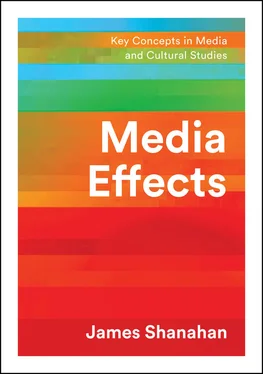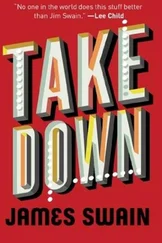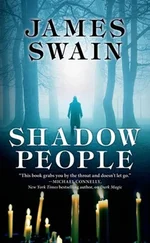The discussion did not end with film. Radio in the 1930s and 1940s was not immune to similar criticism (Dennis, 1998). In the 1950s, comic books were seen by some as particularly nefarious, “seducing” innocent child readers into a sordid life of violence and depravity (Wertham, 1954). The emergence of television then provided a fresh target for these fears. Since television seemingly combined all previous media into one (it was aural, visual, and immediate), its presumed effects were greater. And now fingers point to other media such as video games and the Internet.
“Media effects”: An etymology
Before we delve into the voluminous theoretical and empirical research on these questions, it might behoove us to try to unearth the origins of the terminology we will be using. Where did the idea of “media effects” come from? Who coined the term? What were the conditions of the birth of the idea? There are key readings and moments from the history of social science, and from our own social history, that can help us pin down its origins.
The growth of sociology, psychology, and political science as scientific disciplines was bound to eventually mean a turn toward media questions. The development of media technology has always been a key component in terms of how society has evolved (Innis, 1951; McLuhan, 1964); acceleration in the media sphere was a big part of how overall social change proceeded in the nineteenth and twentieth centuries. Across this period, in relation to emerging media, we can identify two issues that became of prime importance in how researchers would look at media effects: (1) the question of opinions (later also called beliefs and attitudes), and (2) the question of the mass nature of mediated communication.
Much of human history occurred with little attention to the idea of opinion. Under systems of government that were monarchical or feudal, the thoughts and feelings of the average man mattered almost not at all. It wasn’t until the advent of the very gradual process of the assertion of individual human rights in the political sphere, the Enlightenment, that opinions were brought to the fore. As this happened, there were not clear ideas about how opinions were formed, how they were “aggregated” into larger “public opinion,” or whether the process was in any way rational.
One of the key figures in media effects theory, Elisabeth Noelle-Neumann, has given a cogent account of how opinion came to matter along two tracks. First, there is the idea of public opinion as a means through which gradually expanding classes of people contribute to the political discourse in rational ways. This form of public opinion ( raisonnement in the words of the French Enlightenment thinkers) is how we like to think of public opinion (its “sunny side” as Noelle-Neumann puts it) contributing ever more progressively to the development of a politics that can benefit the largest number. People express viewpoints in public settings, and deliberative discourse based on these ideas leads to solutions for the body politic. It’s what we colloquially think of as the “marketplace of ideas.”
On the other side, though, she finds the idea of opinion as social control , looking at the tendencies of people to base their actions not only on their own beliefs and attitudes, but also on what others think about them. Because, as social animals, we need and require approval from the group for what we do, we regulate and censor our own beliefs and activities to assure that they will meet with that approval (Noelle-Neumann, 1993). Thus, we have not only our own rationally-formed individual opinions, but our expression of opinion as conditioned by what the group thinks about us. Because the latter process is based on this need for group approval, it is seen as less rational than raisonnement and ultimately more affective. It can even lead to irrationally-held opinions.
Both tracks of thinking have had great impact on media effects work. Rational ideas about opinion are seen in work that seeks to understand how individuals form opinions; we notice it quite clearly in the frequent use of psychological theories that explain how people extract facts and images from media and build those logically into attitudes and opinions. On this track, media in effect become a prime source of, if not the prime source of, personal opinion. The huge body of literature that has developed on attitude change is of this stripe. Media are seen as variables that can play a direct role in the formation of rationally held attitudes, and they have the capacity to change attitudes that might be strongly held by individuals.
Conversely, the idea of opinion as social control also influenced several major theories of media effect, including Noelle-Neumann’s own “spiral of silence” theory, as well as Gerbner’s “cultivation” theory (more on these later as well). On this darker view of opinion, media messages come to be seen as possibly sinister forces that can “manufacture” opinion in directions sought by elites. Because people have an instinctual need to know what others think about their own opinions, and because media provide the main vehicle for disseminating information about the popularity of opinions, media play an outsize role in drawing support for what eventually become the majoritarian positions. Public susceptibility to media messages, driven by an a-rational need to conform, becomes another important part of the media effects picture, especially in relation to phenomena such as propaganda.
While the study of public opinion was and is contained in a field all its own, it has been heavily influenced by the development of media. Speier (1950) noted:
the history of public opinion has been written primarily with reference to channels of communication, e.g., the marketplace in ancient Greece; the theater in Imperial Rome; the sermons, letters, ballads and travels in the Middle Ages; pamphlets, newspapers, books and lectures, telegraph, radio and film in modern times. (pp. 379–80)
Without sufficient means to carry and represent the views of the people, there is no medium within which opinion can form, as it requires a dynamic and reciprocal process of the creation and sharing of views. Even wearing its darker vestments of social control, opinion adapts to the media of its time. Thus, media channels make an important difference in terms of how opinion is expressed; media matters in the control of opinion as well. It was the evolution of media toward a mass characteristic that made a most important difference for what we now call media effects research.
The “mass,” in sociology, is a very large, heterogeneous social grouping. In the latter half of the 1800s and the first half of the 1900s, it was seen as the dominant social form that the world was emerging into, as powerful forces such as industrialization and urbanization disrupted traditional forms of social organization (Lowery & DeFleur, 1995). In a mass, individual identities and characteristics are subsumed to a larger singular cultural identity. Culture and cultural products are aimed at these large social groupings, with mass culture stereotypically seen as a “lower” or more debased form. The mass encourages cultural producers to appeal to “lowest common denominator” audiences, with commercial motives amplifying tendencies toward lowering cultural standards.
What were the media that created and served this mass? Beginning with the development of mass newspapers in the 1830s, media technology evolved very quickly, including the development of telegraph, telephone, photography, recorded sound, and film, all in a period of less than 100 years. Each new medium brought exciting and radically new possibilities for knowing about the world. Also, they brought social change that was usually poorly understood in terms of its potential negative consequences.
Читать дальше












